Electron paramagnetic resonance (EPR) spectroscopy for investigating murine telogen skin after spontaneous or depilation-induced hair growth
March 2008
in “Journal of Dermatological Science”
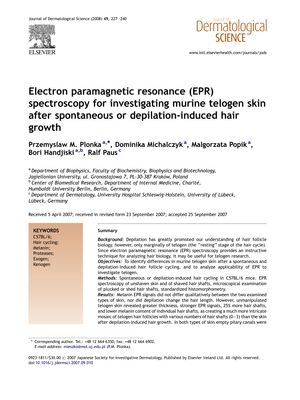
TLDR EPR spectroscopy showed that spontaneous hair growth results in thicker skin and less pigmented hair than depilation-induced growth.
The study used Electron Paramagnetic Resonance (EPR) spectroscopy to compare murine telogen skin after spontaneous hair growth and depilation-induced hair growth. It was found that depilation did not affect the quality of melanin or hair length, but spontaneous telogen skin was thicker, had more hair shafts, and lower melanin content in individual hair shafts than skin after depilation-induced hair growth. The study also noted that both types of skin showed signs of exogen and that telogen is a dynamic phase influenced by the method of hair cycle induction. The results indicate that EPR spectroscopy can be a useful tool for studying hair follicle cycling, and that there are biological differences between spontaneous and depilation-induced telogen skin, particularly in terms of skin thickness and hair shaft pigmentation. The specific number of mice used in the study was not mentioned, and the statistical analysis included Mann-Whitney U-test and Student's t-test.
View this study on jdsjournal.com →
Cited in this study

research Follicular miniaturization in female pattern hair loss: clinicopathological correlations
Hair loss severity relates to increased miniaturization in female pattern hair loss.

research Natural Scalp Hair Regression in Preclinical Stages of Male Androgenetic Alopecia and Its Reversal by Finasteride
Finasteride reverses early hair loss and promotes growth.
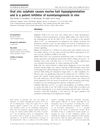
research Oral zinc sulphate causes murine hair hypopigmentation and is a potent inhibitor of eumelanogenesisin vivo
Oral zinc sulphate reduces dark hair color in mice.

research Therapeutic strategies for treating hair loss
The conclusion is that we need more effective hair loss treatments than the current ones, and these could include new drugs, gene and stem cell therapy, hormones, and scalp cooling, but they all need thorough safety testing.

research The hair cycle
The document concludes that the hair cycle is a complex process involving growth, regression, and rest phases, regulated by various molecular signals.
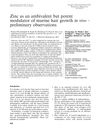
research Zinc as an ambivalent but potent modulator of murine hair growth in vivo- preliminary observations
Zinc can both inhibit and stimulate mouse hair growth, and might help recover hair after chemotherapy.
research The biology of hair shape
research Premature termination of hair follicle morphogenesis and accelerated hair follicle cycling in Iasi congenital atrichia (fzica) mice points to fuzzy as a key element of hair cycle control
The fuzzy gene is crucial for controlling hair growth cycles.
research Hair Follicle Pigmentation
Hair color is determined by melanin produced and transferred in hair follicles.

research Kenogen in Female Androgenetic Alopecia
Kenogen increases with hair loss in women.

research Normal head-hair length is correlated with its diameter
Hair length and thickness are related, with thickness peaking at about a quarter of the hair's maximum length.

research Pathogenesis of androgenetic alopecia
Male pattern baldness involves three mechanisms and finasteride can help reverse it.

research Exogen, Shedding Phase of the Hair Growth Cycle: Characterization of a Mouse Model
Researchers found that hair shedding happens mostly when new hair is growing and involves a unique process.
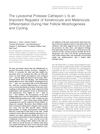
research The Lysosomal Protease Cathepsin L Is an Important Regulator of Keratinocyte and Melanocyte Differentiation During Hair Follicle Morphogenesis and Cycling
Cathepsin L is essential for normal hair growth and development.

research Towards a molecular understanding of hair loss and its treatment
Future hair loss treatments should aim to extend hair growth, reactivate resting follicles, reverse shrinkage, and possibly create new follicles, with gene therapy showing promise.
research Do Hair Bulb Melanocytes Undergo Apotosis During Hair Follicle Regression (Catagen)?
Hair follicle melanocytes die during hair regression.
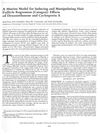
research A Murine Model for Inducing and Manipulating Hair Follicle Regression (Catagen): Effects of Dexamethasone and Cyclosporin A
Dexamethasone speeds up hair loss in mice, while cyclosporin A slows it down.
research Melanogenesis During the Anagen-Catagen-Telogen Transformation of the Murine Hair Cycle
Hair stops producing melanin as it transitions from the growth phase to the resting phase.

research Melanogenesis Is Coupled to Murine Anagen: Toward New Concepts for the Role of Melanocytes and the Regulation of Melanogenesis in Hair Growth.
Hair color production is closely linked to the active growth phase of hair in mice and may also influence hair growth itself.

research Growth of the Hair
Hair growth is cyclic and influenced mainly by local factors.
Related

research Electron paramagnetic resonance (EPR) spectroscopy for investigating murine telogen skin after spontaneous or depilation-induced hair growth
EPR spectroscopy showed that spontaneous hair growth results in thicker skin and less pigmented hair than depilation-induced growth.